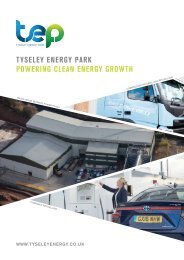connected-clusters-report-energy
Clustering innovation to create thriving and prosperous low-carbon cities and regions
Clustering innovation to create thriving and prosperous low-carbon cities and regions
You also want an ePaper? Increase the reach of your titles
YUMPU automatically turns print PDFs into web optimized ePapers that Google loves.
ConnectedClusters Landscaping Study 22<br />
Energy Capital –<br />
The West Midlands<br />
Energy Cluster<br />
Introduction<br />
The city of Birmingham is a traditional English<br />
city, built on the back of the industrial revolution.<br />
It has a long and strong tradition of industry<br />
and manufacturing which was then steadily<br />
eroded from the 1970s as manufacturing<br />
largely moved overseas following lower cost<br />
labour. In the wake of this change, the city<br />
and region has sought to redevelop itself and<br />
modernise its ageing infrastructure through<br />
redevelopment of the city’s buildings and<br />
transportation and a redefining of the major<br />
employment sectors. This is set against a<br />
backdrop of major cuts to local government<br />
funding and a reduction in capacity to deliver<br />
new initiatives as the size of the city council has<br />
reduced by a factor of more than five.<br />
The space this has created mandates a<br />
stakeholder rather than council- or local<br />
government-led approach to innovation.<br />
The wider West Midlands conurbation<br />
has a rich history as one of Britain’s<br />
industrial heartlands. Described variously<br />
as ‘city of a thousand trades’ and<br />
‘the workshop of the world’, Birmingham is built<br />
on manufacturing, innovation and resourcefully<br />
seizing economic opportunity. As Britain’s<br />
second largest metropole, Birmingham is<br />
a diverse, global city (McEwan, Pollard,<br />
Henry, 2005) 16 .<br />
Throughout the 20th century, Birmingham<br />
came to specialise in the automotive industry.<br />
Austin Rover, later British Leyland and Rover,<br />
was based at Longbridge. Jaguar was based<br />
in nearby Coventry and many other marques<br />
were synonymous with the area. Around these<br />
Original Equipment Manufacturers (OEMs) was<br />
a hinterland of tier 1 suppliers and complex<br />
supply chains which supported a thriving<br />
industrial base.<br />
However, since the 1970s, the West Midlands<br />
has faced more challenging circumstances.<br />
The near-collapse of the British auto-industry in<br />
the latter decades of the 20th century marked<br />
a transition from high levels of employment<br />
and good wages to increasing unemployment<br />
(Centre for Cities, 2014) 17 . The travails of<br />
the car industry were mirrored in any number<br />
of manufacturing sectors, where strong<br />
competition from low-labour cost countries has<br />
led to a decline in mass-manufactured goods.<br />
A case in point is the Tyseley site of the firm<br />
Webster & Horsfall, once home to a large<br />
cable manufacturing concern. Its work was<br />
displayed in the Great Exhibition of 1851 and<br />
the company made the first trans-Atlantic<br />
communication cable. It once manufactured<br />
all manner of cables, wires and ropes.<br />
However, with competition too fierce for<br />
‘low-value’ cable products, the firm now<br />
focuses exclusively on very high end,<br />
specialised cable products with a large<br />
degree of value added. By way of example,<br />
take the cheap bulk wire used in the<br />
reinforcement of car tyres, as an example<br />
of an old and discontinued product.<br />
Contrast this with the high value niche of<br />
orthodontic wires used in dental implants.<br />
The latter have to be produced to exacting<br />
quality standards, in sanitary environment<br />
suitable for medical applications.<br />
The region is in the process of undergoing<br />
a metamorphosis. The renaissance of the<br />
West Midlands is evident in any number of<br />
dimensions – from new city centre architecture<br />
and urban renewal to new transport links and<br />
firms restoring the production of manufactured<br />
goods to the area.




